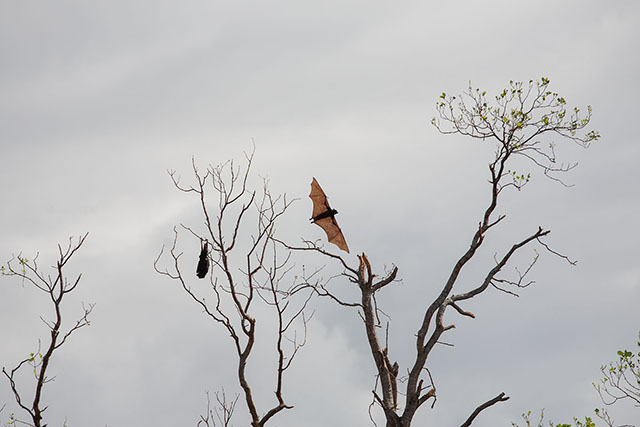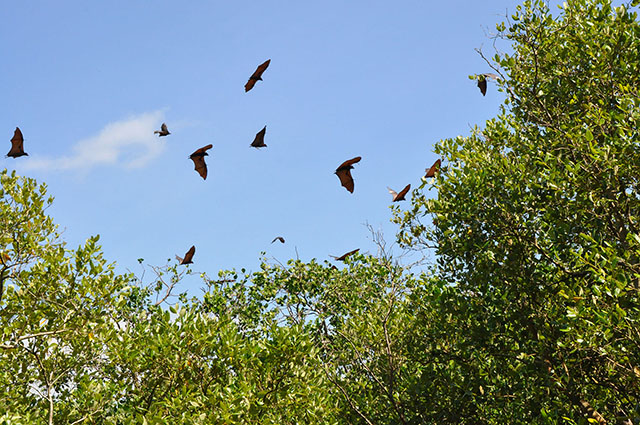 A startled “flying fox” soars as another one sleeps on a mangrove tree devastated by Typhoon Yolanda in what used to be a bat sanctuary in Tabuk Island off Palompon, Leyte in this photo taken Friday, 29 Nov 2013. Over a hundred thousand bats used to roost in Tabuk Island, but most of them flew elsewhere. MindaNews photo by Bobby Timonera
A startled “flying fox” soars as another one sleeps on a mangrove tree devastated by Typhoon Yolanda in what used to be a bat sanctuary in Tabuk Island off Palompon, Leyte in this photo taken Friday, 29 Nov 2013. Over a hundred thousand bats used to roost in Tabuk Island, but most of them flew elsewhere. MindaNews photo by Bobby Timonera
TABUK ISLAND, Palompon, Leyte (MindaNews / 29 November) – The devastation wrought by Typhoon Yolanda in this municipality is substantial, though fortunately the people heeded the call to seek refuge in stronger structures, resulting in only a few casualties.
“But the giant bats of Tabuk Island were the ones caught off guard,” said Raoul Bacalla, the municipal environment and natural resources officer.
This 72-hectare island, with mangroves all over, was declared as a marine park and fish and bird sanctuary in 1996, according to Christopher Montebon, service desk officer of the municipal tourism office who often guide visitors to the island, situated just half a kilometer away from the poblacion.
The municipal government wanted to preserve and protect the rich marine life around it, as well as the migratory birds that often visit the island, he added.
“There were no bats then. But maybe because they noticed that no one is disturbing the island, the bats started coming shortly after,” Montebon said. Soon, tourists came to watch the birds and the bats, and to dive around the island’s crystal clear waters to see the rich marine life, he added.
By 1999, the bats have become so many that they have come to be a part of the Palompon landscape. They would sleep, hanging by the mangrove trees all day long, then they would fly away in droves late in the afternoon to hunt for food.
Bacalla said that before Yolanda came, there must have been 10 colonies of bats at 10,000 per colony. So there must have been at least 100,000 bats before the typhoon.
Bacalla said there are two species of giant bats in the island – the giant golden-crowned flying fox (Acerdon jubatus) and the large flying fox (Pteropus vampyrus). There may be more of the latter, but the former are the bigger bats, among the biggest in the world with wings spanning five to six feet wide, each bat weighting almost a kilo, he added. The golden-crowned flying foxes are also classified as endangered because of poaching and forest destruction.
“It was such a beautiful sight starting around 5 o’clock in the afternoon, when they would all fly together, thousands of them. They would cover the sky and it would go dark for a while,” recalled Marife Matugas, 40, a laundry woman with four children.
“We see them every afternoon, everyday, all year round, but we never got tired watching them,” she added.
Raynato Arat, a native of Iligan City who now works in Saudi Arabia, recalled that in his visit in 2007 for a snorkeling trip around the island, they just had to clap and many of the sleeping bats would fly out. “While in the boat, we had to duck our heads, fearing we’d be hit by the big bats because there were so many of them,” he added.
I’ve seen four beautiful sunsets here since joining my wife in a medical mission, but I have never seen such a spectacle. Not even just a few bats flying in the sky as the sun goes down in the horizon.
 Giant bats fly over lush mangrove trees in Tabuk Island off Palompon, Leyte in this photo taken March 2012. Over a hundred thousand bats used to roost in Tabuk Island, but most of them flew elsewhere when Typhoon Yolanda hit the island. Photo courtesy of Raoul Bacalla / MENRO-Palompon
Giant bats fly over lush mangrove trees in Tabuk Island off Palompon, Leyte in this photo taken March 2012. Over a hundred thousand bats used to roost in Tabuk Island, but most of them flew elsewhere when Typhoon Yolanda hit the island. Photo courtesy of Raoul Bacalla / MENRO-Palompon
Bacalla is hopeful the bats were not killed with Yolanda’s fury because they have not seen their floating bodies after the storm. “Most likely they just flew away to find temporary roosts,” he said.
“We have heard of reports that some bat colonies have gone to other barangays in the municipality, like in Cantuhaon where there are many mangroves too, and neighboring towns like Villaba,” he said. “The fact that there were no such bat colonies in those areas before, we are sure those bats are from Tabuk Island,” Bacalla added.
The fruit-eating flying foxes, he said, have their use because they are known as “silent pollinators” or “silent planters” as they drop seeds while flying, thus helping maintain the forests.
But the bats almost disappeared after the storm.
He pointed out, though, that the catastrophe may be nature’s way of controlling the bats’ population because they had grown so much in number. “We heard some farmers complaining that the bats are attacking their fruits,” Bacalla said.
But still, Bacalla wished the bats would come back. “Maybe we now have a few hundreds of the bats, and we’re hoping they’d all come back because they have become part of our daily life,” he said.
In my boat ride around the island on Friday morning, we saw some bats hanging by the mangrove trees, soundly sleeping under the midmorning sun. But the startled few flew around the island to look for another roosting place.
Should the bats come back, Bacalla vowed to protect the nocturnal creatures even more, especially since some Palompon folk, including children, have now resorted to “kite fishing” – placing fishing hooks in the kite’s thread – from the mainland because they are prohibited from poaching bats in the island.
Bat meat, locals say, is delicious and invigorating.
“We have prohibited the practice, but we don’t have enough manpower to enforce the ban,” Bacalla lamented. “We have 27 kilometers of coastline to watch, so we have asked the different barangays to help out,” he said.
Bacalla said it is important to protect Tabuk Island, too, because it serves as a natural barrier against the big waves. While there were reports of storm surges in other parts of Leyte and Samar, he said the island had protected Palompon from even greater devastation.
One step the municipal government has taken, he said, is to require all elementary and high school students to undergo a seminar on coastal resource management. “We bring them to the island to show the importance of the mangroves to the marine life, the birds and the bats,” Bacalla said. (Bobby Timonera / MindaNews)
